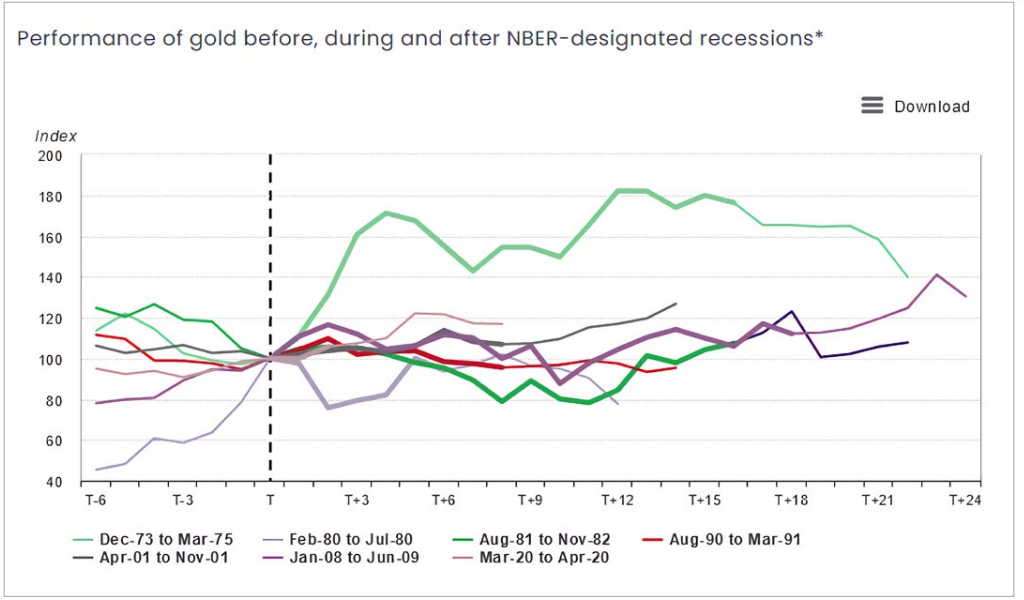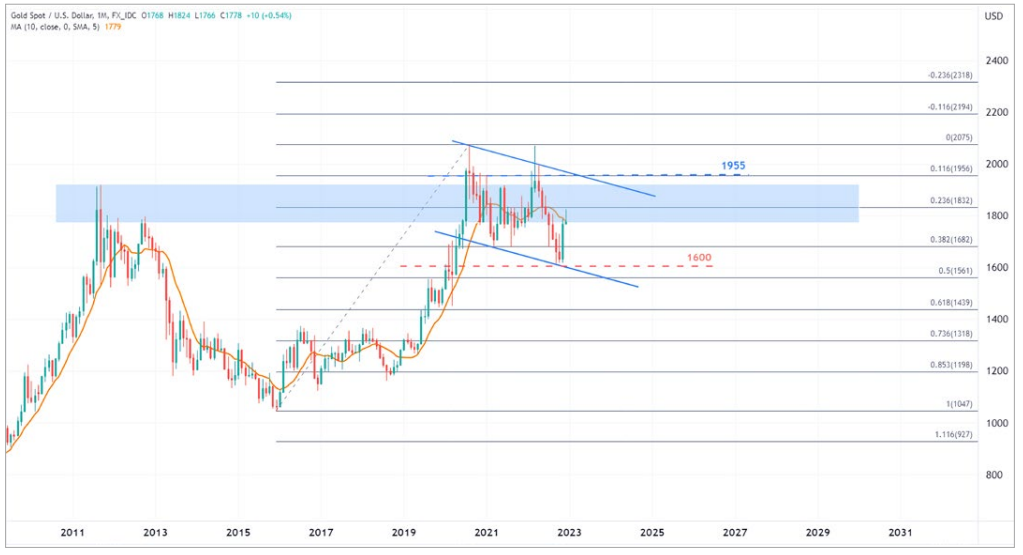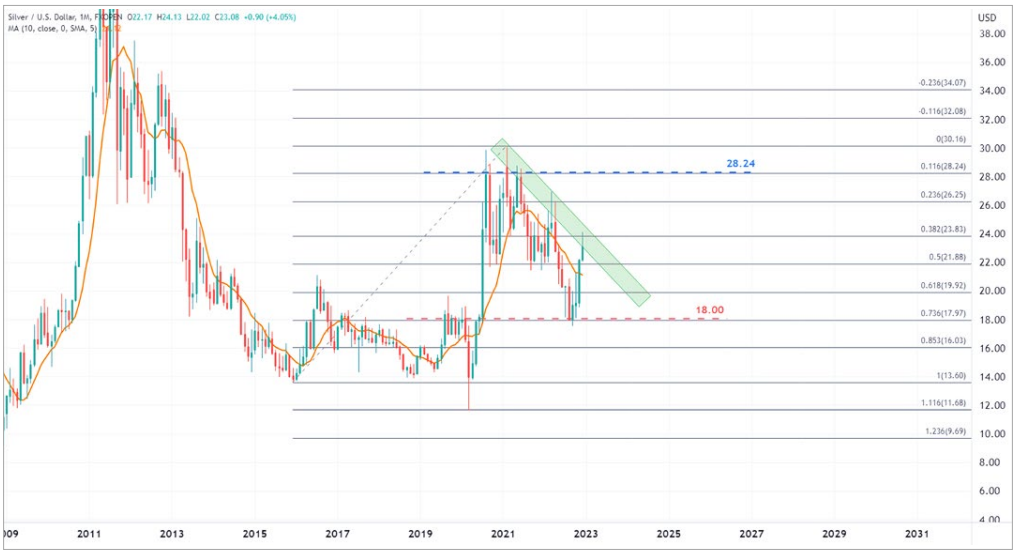
ATFX Trader Magazine
Gold & Silver - A Recession May Boost Prices Amid Rate Hike Pressure
newsroom
Publish date: Tue, 17 Jan 2023, 11:30 AM
Gold prices showcased robust performance on the first trading day of December, topping $1,800 and returning to the levels recorded in early 2022. However, this did not translate into a strong rally as the yellow metal stagnated. The Fed rate hikes and inflation will continue to influence gold prices in 2023, with a global economic recession providing tangible support.
Although the Fed has eased the size of its rate hikes since December 2022, the rate hiking cycle continues, with the federal funds rate expected to hit 5.50% by mid-2023. Before the Fed makes an apparent policy shift, there is still room for gold prices to edge lower. Falling inflation will eventually push real yields higher, and they will only pull back if the Fed suspends its rate hikes.
In other words, changes in the dollar and bond yields will continue to drive gold price volatility. However, as the Fed takes a slower approach to rate hikes, the dollar is expected to have less momentum in the new year than in 2022. Hence, exerting less pressure on gold prices and increasing the yellow metal’s allure.
Although gold’s performance was not eye-catching in 2022, it still outperformed the US stock and bond markets and the S&P 500 Index despite hitting the yearly low of $1,618. According to previous trends, a further slowdown in economic growth will squeeze corporate profit margins attracting investment capital to the precious metals market.
Suppose the US economic downturn worsens and a recession emerges during the same period. In that case, the safe-haven role of precious metals could cushion investors from the pressure of high interest rates and support a bottom in gold prices. According to the World Gold Council (WGC), gold has generated positive returns in five of the last seven recessions. There is one caveat: a “soft landing” of the economy will be less supportive of gold prices.

Although an economic recession is good for gold to act as a safe-haven instrument, inventors should pay attention to economic pressure, which is one of the negative factors for silver. The economic downturn directly weakens industrial demand and suppresses silver prices. Since over 50% of silver demand comes from industrial use, silver may experience more significant price fluctuations than gold.
On the economic front, it is worth noting that some Asian countries are recovering much more quickly than major economies in Europe and the US, fueling an improvement in the demand for physical gold and silver. The economic recovery of the leading gold-consuming countries (like China and India) in Asia could trigger a rebound in the consumer market, boosting gold prices as physical demand for precious metals increases.
In addition, central banks’ continuous buying of gold is another contributor to high prices. As of October 2022, global central bank gold reserves reached the highest level since November 1974. Last year saw strong net buying of gold, which is expected to continue in 2023.
Gold Technical Analysis
As shown in the monthly chart below, spot gold prices have regained momentum after securing support at the lower side of the descending channel since the beginning of the second half of 2022 and are now testing the $1,800 psychological mark. If the prices stay above this crucial level, investors should note that the $1,800 to $1,920 range has seen active trading. A period of consolidation cannot be ruled out, and the chances of breaching the upper bound of the channel during the period are worth considering. A further increase to $1,955 is likely, which has served as crucial resistance many times before and may soon act as a trigger for a technical pullback. Considering that the market has foreseen the possibility of interest rates cut by the Fed, gold prices will hardly break through $2,000 in Q1 unless the global economy suffers a sharp recession.
On the contrary, we believe the dollar will likely remain the safe-haven asset of choice as the global economy faces significant downward pressure. The Fed has already predicted in its December minutes that interest rates will rise to the terminal rate and that the high rates will linger much longer. The overall rebound of gold prices will still be subject to headwinds before the Fed decides to reverse the direction of its policies. Under these circumstances, there is a chance that gold prices may head towards the critical support at $1,600. There is a lower support at $1,561, and the support zone at the lower end of the descending channel will be tested again.

According to the monthly chart, spot silver prices are trying to move closer to the upper side of the descending channel, with the $24 mark possibly serving as resistance. If the level is smashed thanks to the favourable fundamentals mentioned above, silver prices will test $26.25, with the next critical resistance being $28.24. On the support front, the 10-day moving average may exceed $18 if the preliminary support is breached, entering the active trading range from August 2019 to February 2020.

By Jessica Lin, ATFX (Asia Pacific) Global Market Analyst
More articles on ATFX Trader Magazine
Crude Oil - Will Crude Oil Rally Despite Market Worries About an Economic Recession?
Created by newsroom | Jan 17, 2023
USDCAD - The BoC Could Provoke Economic, Oil Price and CAD Price Shocks
Created by newsroom | Jan 17, 2023
European Stock Indices - How Will Euro Stocks Perform vs Monetary Tightening and a Recession?
Created by newsroom | Jan 17, 2023
Discussions
Be the first to like this. Showing 0 of 0 comments












.png)








